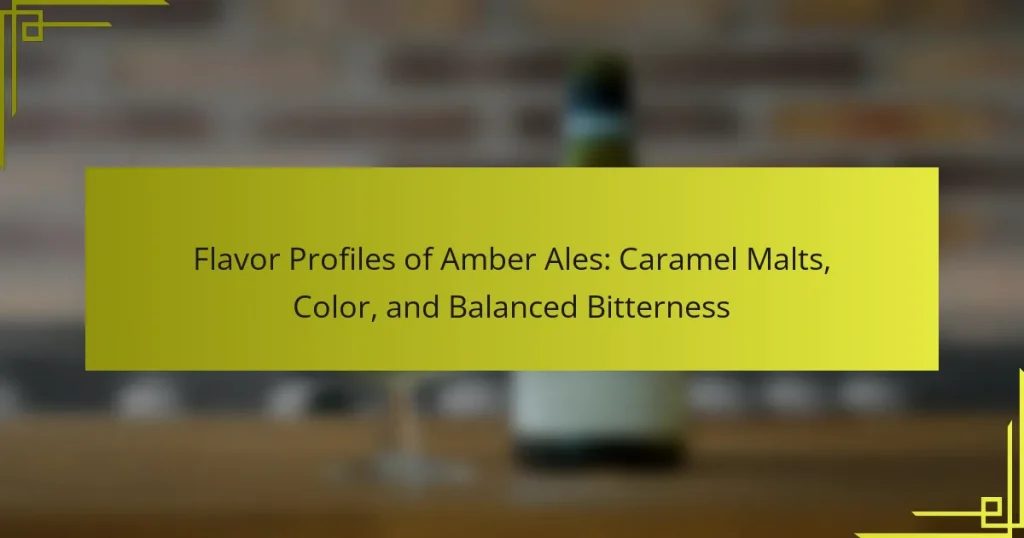Amber ales are a style of beer known for their amber to copper color and balanced flavor profile. These ales feature caramel malts that provide sweetness and richness, complemented by moderate hop bitterness. With an alcohol content typically ranging from 4.5% to 6.5%, amber ales are characterized by their smooth mouthfeel and drinkability. The article will explore the flavor profiles of amber ales, highlighting the influence of caramel malts, the significance of color, and the role of balanced bitterness in creating a complex tasting experience. Additionally, it will provide serving suggestions and food pairings to enhance the enjoyment of amber ales.

What are Amber Ales and their Flavor Profiles?
Amber ales are a type of beer characterized by their amber to copper color. They typically have a balanced flavor profile that includes caramel malt sweetness and moderate hop bitterness. The caramel malts contribute notes of toffee and caramel, enhancing the beer’s richness. Amber ales usually have an alcohol content ranging from 4.5% to 6.5%. The hop presence is often subtle, allowing the malt flavors to shine through. This style of ale is known for its smooth mouthfeel and drinkability. Amber ales are popular in various beer markets, appealing to those who enjoy a malt-forward beverage.
How do caramel malts contribute to the flavor of Amber Ales?
Caramel malts contribute sweetness and complexity to Amber Ales. They provide flavors such as toffee, caramel, and nutty notes. These malts enhance the overall mouthfeel, adding a smooth texture. The color of Amber Ales is often influenced by the use of caramel malts, giving them a rich amber hue. Caramel malts can also balance the bitterness from hops. This balance is crucial for creating a harmonious flavor profile. The sweetness from caramel malts counteracts the bitterness, making the beer more approachable. Overall, caramel malts are essential in defining the taste and character of Amber Ales.
What specific flavors do caramel malts impart to Amber Ales?
Caramel malts impart flavors of toffee, caramel, and light brown sugar to Amber Ales. These malts contribute sweetness and a rich, smooth mouthfeel. The toasty notes enhance the overall complexity of the beer. Additionally, caramel malts can introduce hints of chocolate and nuttiness. This flavor profile balances well with the moderate hop bitterness typical in Amber Ales. The use of caramel malts is essential in achieving the desired amber color and flavor depth. Their presence is a defining characteristic of this beer style.
How does the roast level of caramel malts affect the overall taste?
The roast level of caramel malts significantly influences the overall taste of amber ales. Lighter roast levels impart sweetness and a smooth, toasty flavor. As the roast level increases, the flavor becomes richer and more complex. Medium roast levels add notes of caramel, toffee, and a slight nuttiness. Darker roasts contribute deeper flavors, including chocolate and coffee undertones. The balance of sweetness and bitterness is affected by the roast level as well. Higher roast levels can lead to a more pronounced bitterness. This complexity enhances the overall flavor profile of amber ales, making them more enjoyable.
What role does color play in the perception of Amber Ales?
Color significantly influences the perception of Amber Ales. The hue of an Amber Ale typically ranges from amber to copper. This visual characteristic can signal to consumers the flavor profile and malt characteristics. A darker color often suggests a richer, maltier taste, while a lighter shade may indicate a more subtle flavor. Research indicates that consumers associate deeper colors with sweetness and complexity. Additionally, the color can affect initial expectations and overall enjoyment. Studies show that color impacts taste perception, as individuals may perceive darker beers as having more body and flavor. Thus, color plays a crucial role in shaping the overall experience of Amber Ales.
How is the color of Amber Ales determined?
The color of Amber Ales is determined primarily by the type and amount of malts used in the brewing process. Caramel malts, which are often used, contribute a rich amber hue. The Maillard reaction during the malting process also affects color depth. Additionally, the brewing technique, including the temperature and duration of the boil, influences the final color. Typically, Amber Ales range from light amber to deep copper shades. The specific gravity of the wort before fermentation can also play a role in color intensity. Overall, the combination of malt selection and brewing methods defines the characteristic color of Amber Ales.
What does the color indicate about the flavor profile?
The color of amber ales indicates a rich, malty flavor profile. Darker hues suggest the presence of caramel malts. These malts contribute sweetness and depth to the beer’s taste. Lighter shades may indicate a more balanced flavor with less sweetness. The intensity of the color often correlates with the complexity of the flavor. For example, deeper amber colors can denote roasted notes. This relationship between color and flavor is well-documented in brewing science. Studies show that consumers often associate darker beers with richer flavors.
Why is balanced bitterness important in Amber Ales?
Balanced bitterness is important in Amber Ales because it enhances the overall flavor profile. This balance allows the sweetness from caramel malts to shine through without being overwhelmed. A well-measured bitterness provides a counterpoint to the malt sweetness, creating a harmonious taste experience. It also helps to cleanse the palate, making the beer more refreshing. In Amber Ales, the bitterness typically ranges from 20 to 40 IBU (International Bitterness Units). This range ensures that the bitterness is noticeable yet not dominant. Ultimately, balanced bitterness contributes to the complexity and drinkability of Amber Ales.
How is bitterness measured in Amber Ales?
Bitterness in Amber Ales is measured in International Bitterness Units (IBUs). IBUs quantify the concentration of bitter compounds, primarily iso-alpha acids derived from hops. The scale typically ranges from 10 to 50 IBUs for Amber Ales. Higher IBU values indicate more pronounced bitterness. Various factors influence the IBU measurement, including hop variety and timing of addition during brewing. The balance of malt sweetness and hop bitterness is essential in Amber Ales, contributing to their flavor profile. This balance is often described as smooth and approachable, enhancing drinkability.
What impact does balanced bitterness have on the overall drinking experience?
Balanced bitterness enhances the overall drinking experience by providing a counterpoint to sweetness. This balance creates a more complex flavor profile. It prevents the drink from being overly sweet or cloying. The presence of bitterness can also stimulate the palate. It encourages the drinker to take another sip. Studies show that balanced bitterness can improve drinkability. This leads to increased enjoyment and satisfaction. In amber ales, this attribute is crucial for flavor harmony.

What are the key attributes of Amber Ales?
Amber Ales are characterized by their rich malt profile, vibrant color, and balanced bitterness. They typically feature caramel malts, which contribute sweetness and depth. The color ranges from amber to copper, indicating the malt’s influence. Balanced bitterness comes from hops, enhancing flavor without overpowering sweetness. Alcohol content usually falls between 4.5% and 6.5%. These ales often exhibit fruity and floral notes, adding complexity. Overall, Amber Ales are known for their smooth mouthfeel and drinkability.
What are the common characteristics shared by Amber Ales?
Amber Ales typically feature a medium to deep amber color. They are characterized by a balanced malt profile, often highlighting caramel and toasty flavors. The bitterness is moderate, providing a harmonious contrast to the sweetness of the malts. Amber Ales usually have an alcohol content ranging from 4.5% to 6.5%. Their aroma often includes hints of caramel, toffee, and sometimes floral or citrus notes from hops. These beers are often brewed with a combination of pale and caramel malts. The finish is generally smooth and slightly sweet, making them approachable for a wide range of beer drinkers.
How do the ingredients influence the flavor and aroma?
Ingredients in amber ales significantly influence flavor and aroma. Caramel malts provide sweetness and rich, toasty flavors. These malts contribute notes of caramel, toffee, and sometimes chocolate. The hops used balance the sweetness with bitterness, adding floral and citrus aromas. Yeast also plays a role, imparting fruity esters that enhance complexity. The combination of these elements creates a well-rounded flavor profile. Research indicates that specific malt and hop combinations can enhance certain aromatic compounds, resulting in a more pronounced flavor experience.
What unique attributes distinguish Amber Ales from other beer styles?
Amber Ales are distinguished by their rich caramel malt flavors, which provide a sweet, toasty character. This sweetness is balanced by moderate hop bitterness, creating a well-rounded taste. The color of Amber Ales typically ranges from amber to copper, giving them a visually appealing hue. Unique to this style is the use of specific malt varieties, such as Crystal or Caramel malts, that enhance flavor complexity. Amber Ales also often have a medium body, making them approachable for a wide range of beer drinkers. Their carbonation level is generally moderate, which contributes to a smooth mouthfeel. These attributes set Amber Ales apart from lighter lagers and darker stouts, emphasizing their unique flavor profile.
How does the brewing process affect the flavor profiles of Amber Ales?
The brewing process significantly influences the flavor profiles of Amber Ales. The selection of malts affects sweetness and color. Caramel malts contribute to the characteristic caramel and toasty flavors. The mashing temperature impacts sugar extraction, altering sweetness levels. Hops balance the malt sweetness with bitterness, enhancing complexity. Fermentation temperatures affect yeast activity, influencing fruity or estery notes. The duration of aging can mellow harsh flavors, leading to a smoother finish. Additionally, water chemistry plays a role in flavor perception. These factors collectively shape the unique taste and aroma of Amber Ales.
What techniques are used to enhance caramel malt flavors?
Techniques to enhance caramel malt flavors include using specific malt types, adjusting mash temperatures, and employing caramelization processes. Selecting specialty malts, such as crystal or caramel malts, contributes rich, sweet flavors. Higher mash temperatures, typically around 156-162°F, promote unfermentable sugars, enhancing sweetness. Additionally, caramelization can be achieved through methods like decoction mashing. This technique involves boiling a portion of the mash to develop deeper flavors. Roasting grains at controlled temperatures also intensifies caramel notes. These methods are widely used in brewing to achieve desired flavor profiles in amber ales.
How does fermentation influence the bitterness and aroma?
Fermentation significantly influences the bitterness and aroma of amber ales. During fermentation, yeast converts sugars into alcohol and produces various compounds. These compounds include esters and phenols, which contribute to fruity and spicy aromas. The fermentation temperature affects the types and amounts of these compounds produced. Higher temperatures typically increase ester production, enhancing aroma complexity. Additionally, the interaction between yeast and hops during fermentation can modify perceived bitterness. Yeast may bind to hop compounds, altering their bitterness profile. This interaction creates a more balanced flavor, integrating bitterness with aromatic elements. Overall, fermentation shapes the overall sensory experience of amber ales.

What are the best practices for enjoying Amber Ales?
To enjoy Amber Ales, serve them at a temperature between 45°F and 55°F. This temperature range enhances their flavor profile. Use a tulip or pint glass to concentrate the aromas. Pour the ale gently to preserve carbonation. Pair Amber Ales with foods like grilled meats, roasted vegetables, or spicy dishes. The caramel malts complement these flavors. Take small sips to savor the balanced bitterness and malt sweetness. This approach allows for a better tasting experience.
What food pairings complement Amber Ales?
Amber Ales pair well with a variety of foods. Grilled meats enhance the caramel malt flavors. Barbecue ribs are a popular choice. Roasted vegetables also complement the beer’s sweetness. Aged cheeses, like cheddar, balance the bitterness. Spicy dishes, such as buffalo wings, contrast nicely with the malt profile. These pairings are supported by the beer’s flavor characteristics. Amber Ales have a moderate bitterness that allows versatility in food combinations.
How does the flavor profile of Amber Ales enhance various dishes?
The flavor profile of Amber Ales enhances various dishes through its caramel malt sweetness and balanced bitterness. The caramel malts provide a rich, toasty flavor that complements roasted meats and hearty stews. This sweetness can also contrast well with spicy dishes, balancing heat and adding depth. The moderate bitterness from hops cuts through fat, making Amber Ales ideal for pairing with fried foods or creamy sauces. Additionally, the amber color adds visual appeal to the dining experience. Overall, the unique combination of flavors in Amber Ales creates a versatile pairing option for a wide range of cuisines.
What are the ideal serving temperatures for Amber Ales?
The ideal serving temperature for Amber Ales is between 45°F to 55°F (7°C to 13°C). This temperature range allows the caramel malts to express their flavors fully. Serving Amber Ales too cold can mute these flavors. Conversely, serving them too warm can enhance bitterness, overshadowing the malt profile. Many beer enthusiasts recommend a temperature closer to 50°F (10°C) for optimal enjoyment. This ensures a balanced tasting experience, highlighting both malt sweetness and hop bitterness.
What tips can enhance the tasting experience of Amber Ales?
To enhance the tasting experience of Amber Ales, consider the following tips. Serve Amber Ales at the optimal temperature of 45-55°F for better flavor release. Use a tulip glass to concentrate the aromas. Swirl the beer gently to aerate it, which helps in unlocking its full bouquet. Take small sips to appreciate the complexity of caramel malts and balanced bitterness. Pair Amber Ales with complementary foods like grilled meats or spicy dishes to enhance the flavor profile. Additionally, take note of the beer’s appearance, as the rich amber color can influence perception. Engaging all senses during tasting can lead to a more enjoyable experience.
How should Amber Ales be poured for optimal flavor release?
Amber Ales should be poured at a 45-degree angle to enhance flavor release. This technique helps minimize excessive foam while allowing the beer to aerate. Pouring in this manner encourages the release of aromatic compounds. These compounds contribute to the overall flavor experience. Additionally, serving Amber Ales in a tulip glass can further concentrate the aromas. The glass shape directs the scents toward the nose. This enhances the perception of the beer’s caramel malts and balanced bitterness. Proper pouring techniques maximize the enjoyment of Amber Ales.
What are common mistakes to avoid when tasting Amber Ales?
Common mistakes to avoid when tasting Amber Ales include not properly examining the appearance. Amber Ales should have a rich amber to copper color. Skipping the aroma assessment is another error. The scent reveals caramel and malt characteristics. Not taking small sips can hinder the tasting experience. Small sips allow for better flavor recognition. Ignoring the mouthfeel is also a mistake. Amber Ales typically have a medium body and moderate carbonation. Lastly, failing to consider the balance of sweetness and bitterness can lead to misinterpretation. The ideal Amber Ale has a harmonious blend of these elements.
Amber Ales are a distinct style of beer known for their amber to copper color, balanced flavor profile, and moderate alcohol content ranging from 4.5% to 6.5%. This article explores the key attributes of Amber Ales, focusing on the contributions of caramel malts to flavor and sweetness, the significance of color in flavor perception, and the importance of balanced bitterness. Additionally, it examines how brewing techniques and fermentation impact the overall taste experience, along with best practices for serving and pairing Amber Ales with food to enhance enjoyment.




